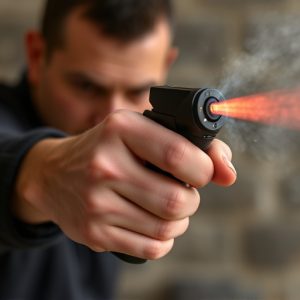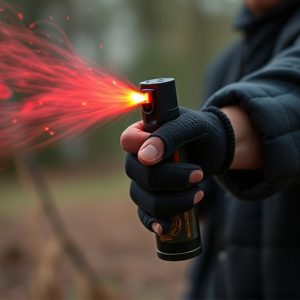Pepper Spray Mastery: Navigating Wind for Optimal Civilian Protection
TL;DR: Effective use of pepper spray for civilian protection requires understanding wind direction t…….
TL;DR: Effective use of pepper spray for civilian protection requires understanding wind direction tips. Aim into or slightly across the wind at close range to maximize impact on attackers. Holding canisters upright, using short bursts, and avoiding strong winds or open areas prevent accidental inhalation. Adhering to legal restrictions and ethical considerations, such as minimizing bystander harm, is paramount.
Pepper spray has emerged as a powerful tool for civilian protection, offering a non-lethal means of self-defense against potential threats. In this comprehensive guide, we explore the intricacies of pepper spray, from its composition and effects to navigating wind direction and optimal deployment techniques. Additionally, we delve into legal and ethical considerations surrounding its use, providing essential tips for maximizing safety and protection while adhering to relevant regulations. Learn how to make informed decisions and stay secure with these valuable insights on pepper spray wind direction and tips.
- Understanding Pepper Spray: Its Composition and Effects
- Navigating Wind Direction: A Crucial Factor for Effective Deployment
- Tips for Optimal Use: Ensuring Maximum Protection and Safety
- Legal and Ethical Considerations for Civilian Self-Defense
Understanding Pepper Spray: Its Composition and Effects
Pepper spray, a civilian protection tool, is a capsaicin-based agent that, when sprayed, can temporarily disable an attacker. Its composition includes a blend of capsicum extracts, often from chili peppers, combined with other ingredients to enhance its effectiveness and reduce wastage. The active ingredient, capsaicin, triggers a burning sensation in the eyes and respiratory system by binding to specific nerve receptors, leading to irritation and discomfort. This reaction can last for several minutes, providing users with valuable time to escape or de-escalate a situation.
Understanding the wind direction tips when using pepper spray is crucial for its effectiveness and safety. Spraying into the face of an attacker, at close range, ensures direct contact with their eyes and skin, maximizing the impact. However, being aware of the wind’s direction is essential to avoid accidental inhalation by the user or bystanders. When possible, spray in a way that allows the breeze to carry the spray away from you, ensuring it doesn’t blow back towards you or others nearby. This simple technique can significantly enhance the safety and success of civilian protection measures.
Navigating Wind Direction: A Crucial Factor for Effective Deployment
Navigating wind direction is a crucial factor for effective deployment of pepper spray for civilian protection. When using pepper spray, understanding the wind pattern can significantly enhance its impact and range. It’s essential to consider the direction and strength of the wind before spraying. If the wind is blowing towards your target, it can disperse the spray more quickly, reducing its effectiveness. Conversely, if the wind is behind you, the spray could blow back towards you, leading to potential self-exposure.
For optimal results, aim pepper spray into the wind or slightly across it. This technique allows for better control over the spray pattern and increases the likelihood of direct contact with the intended target. Remember, proper timing and positioning relative to the wind are as important as the quality of your spray. Always practice in controlled environments to ensure you’re comfortable with these Pepper Spray Wind Direction Tips before relying on them in real-life situations.
Tips for Optimal Use: Ensuring Maximum Protection and Safety
When using a pepper spray for civilian protection, understanding the wind direction is crucial for optimal effectiveness and safety. Always assess the wind speed and direction before deploying the spray. Aiming into the wind ensures the irritant reaches the intended target directly, maximizing its impact. Conversely, spraying against the wind can cause the irritant to blow back towards you, negating its protective effect and potentially exposing you to harm.
For maximum protection, hold the canister upright and aim at close range. Pepper spray is most effective when used in short bursts, allowing for better control and minimizing the risk of exposure to yourself or bystanders. Avoid spraying in strong winds or open areas where the irritant could spread uncontrollably. Regularly test your spray’s functionality and ensure proper storage conditions to maintain its potency, ensuring you are prepared should an unexpected situation arise.
Legal and Ethical Considerations for Civilian Self-Defense
When considering civilian self-defense options, especially those involving inflammatory sprays like pepper spray, it’s imperative to navigate a complex interplay of legal and ethical factors. The use of such tools for personal safety is not universally prohibited, but regulations vary widely across jurisdictions. In many regions, civilians can legally carry and utilize pepper spray for self-defense, subject to specific restrictions on capacity, age limits, and registration requirements. However, understanding the legal framework is just the first step; users must also be acutely aware of ethical considerations.
For instance, the wind direction tips for using pepper spray are crucial not only for its effectiveness but also for minimizing harm to bystanders. Responsible users should always consider the potential reach and impact area of their spray, ensuring they target assailants directly while attempting to avoid dispersing the irritant into populated areas or sensitive environments. Ethical usage involves a mindful balance between protecting oneself and one’s community from violence, adhering to legal boundaries, and respecting personal freedoms and safety for all individuals involved.
Pepper spray can be a powerful tool for civilian protection, but its effectiveness depends greatly on understanding wind direction and optimal deployment techniques. By considering these factors and adhering to legal and ethical guidelines, individuals can enhance their safety while using pepper spray responsibly. Remember, proper training and practice are key to ensuring maximum protection in any self-defense scenario.


